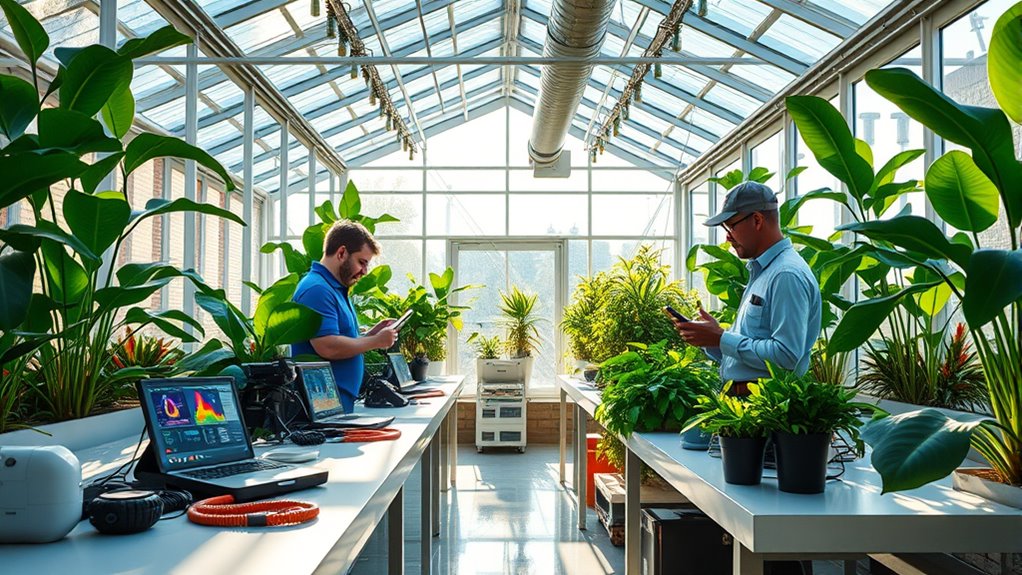Conducting an energy audit for your greenhouse helps you identify inefficiencies and enhance your systems, saving you money and boosting sustainability. Focus on evaluating your lighting, especially upgrading to energy-efficient LEDs and smart controls, alongside inspecting ventilation for proper airflow and automation. Ensuring these systems work together prevents energy waste and maintains ideal conditions for plant growth. If you’re ready to improve your greenhouse’s efficiency, discovering more about effective strategies can make a big difference.
Key Takeaways
- Conduct comprehensive assessments of lighting and ventilation systems to identify inefficiencies and optimize energy use.
- Evaluate lighting fixtures, switches, and controls, prioritizing energy-efficient LEDs and smart automation to reduce consumption.
- Inspect ventilation equipment for proper sizing, operation, and potential leaks, integrating sensors for responsive environmental control.
- Analyze system interactions to ensure effective heat management and solar gain control, maximizing overall energy savings.
- Implement practical upgrades and regularly monitor performance to sustain efficiency, reduce costs, and promote sustainable greenhouse operation.

Conducting energy audits for greenhouse facilities is a essential step toward reducing operational costs and enhancing sustainability. When you perform these audits, you gain a clear understanding of how your energy is being used and where improvements can be made. One of the key areas to focus on is lighting efficiency. Greenhouses rely heavily on supplemental lighting to support plant growth, especially during shorter daylight months. If your lighting system isn’t optimized, you could be wasting a considerable amount of energy. During the audit, you’ll evaluate the types of bulbs and fixtures you’re using, ensuring they’re energy-efficient LEDs rather than older, less efficient options. You’ll also assess the placement and control of lighting systems to prevent unnecessary usage when natural light suffices. Upgrading to smart lighting controls can help you reduce energy consumption by turning lights on only when needed, further increasing efficiency.
Ventilation systems are another critical component to examine closely. Proper ventilation maintains ideal temperature, humidity, and airflow levels inside your greenhouse, directly impacting plant health and energy use. Inefficient ventilation can cause your heating or cooling systems to work harder than necessary, increasing energy bills. During your energy audit, you’ll check if your ventilation fans and exhaust systems are appropriately sized and functioning correctly. You’ll want to identify any leaks or blockages that reduce airflow or cause uneven distribution. Consider whether your ventilation system is integrated with sensors and automation controls, allowing it to respond dynamically to changing environmental conditions. Automating ventilation can lead to substantial energy savings by preventing over-ventilation and reducing unnecessary fan operation during mild weather. Additionally, exploring energy-efficient solutions can further optimize your greenhouse operations and reduce overall energy consumption.
In addition to inspecting individual components, you’ll analyze how lighting and ventilation systems work together. For example, if your ventilation system isn’t effectively managing heat buildup caused by lighting or solar gain, you might be wasting energy on unnecessary cooling or heating. Ensuring these systems are coordinated can maximize energy savings. Remember, the goal of your audit isn’t just to identify problems but to develop practical solutions. Upgrading lighting to more efficient options and optimizing ventilation controls can considerably cut energy costs while improving plant growth conditions. Implementing these improvements may require upfront investment, but the long-term savings and sustainability benefits make it worthwhile. By staying proactive and regularly conducting energy audits, you keep your greenhouse operating at peak efficiency, reducing environmental impact and strengthening your bottom line.
Frequently Asked Questions
What Are the Common Cost Savings From Greenhouse Energy Audits?
You can see significant cost reduction opportunities from greenhouse energy audits by identifying inefficiencies and optimizing systems. These audits often reveal efficiency improvements such as better insulation, upgraded lighting, and improved ventilation, which lower energy consumption. As a result, you’ll reduce operational costs and greenhouse gas emissions. Regular audits guarantee ongoing savings, helping you maintain a sustainable, cost-effective operation while maximizing productivity and environmental benefits.
How Long Does a Typical Energy Audit Take for a Greenhouse?
A typical greenhouse evaluation for an energy audit takes about 1 to 3 days, depending on the size and complexity of your facility. The audit duration involves inspecting your greenhouse systems, analyzing energy use, and identifying inefficiencies. You’ll find that a thorough assessment helps pinpoint specific areas for improvement, ensuring you get actionable insights without taking up too much of your time. This efficient process helps maximize your energy savings quickly.
Are There Any Incentives or Rebates Available for Energy Audits?
A penny saved is a penny earned, so take advantage of available incentives. You can often access government programs and tax credits for energy audits, which can considerably reduce your costs. These rebates are designed to encourage energy efficiency, helping your greenhouse save money and operate more sustainably. Check with local and federal agencies to find specific programs, and don’t miss out on these valuable financial benefits.
How Often Should a Greenhouse Undergo an Energy Audit?
You should schedule an energy audit for your greenhouse every 1 to 3 years, depending on your maintenance schedule and operation size. Regular audits help identify energy inefficiencies and guarantee your systems run smoothly. Keep an eye on changing technology and energy costs, and adjust your audit frequency accordingly. Consistent assessments help optimize your greenhouse’s performance, save money, and support sustainable practices.
What Specific Equipment Is Evaluated During an Energy Audit?
Think of your greenhouse’s equipment as the vital organs of a thriving plant. During an energy audit, you evaluate lighting systems and climate control equipment to guarantee efficiency. This includes inspecting lamps, sensors, HVAC units, fans, and insulation. You look for energy-wasting issues, outdated fixtures, or malfunctioning controls. By fine-tuning these elements, you boost your greenhouse’s health, save costs, and create an ideal environment for your plants to flourish.
Conclusion
Think of your greenhouse as a thriving garden of opportunity. Conducting energy audits is like tending to its roots, revealing hidden leaks and inefficiencies that sap its importance. By nurturing these insights, you guarantee your facility blooms with efficiency and sustainability. Remember, every small adjustment is a seed sown for a greener, more prosperous future. Embrace these audits as your guiding compass—leading your greenhouse toward a brighter, more resilient tomorrow.










